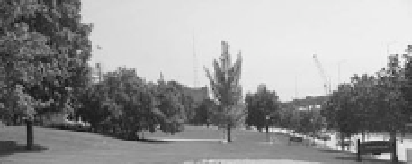Environmental Engineering Reference
In-Depth Information
(a) (b)
Fig. 2.8
(a) Mulching with straw on a disturbed rain garden in the Marquette University campus, the U.S.; (b) two
weeks late the grass re-established itself through the straw
water content of a permeable soil is favorable for plant growth, although it may reduce slope stability in
some situations.
By identifying erodible soil types early in the planning process, the site planner can know what
portions of the site require the most diligent erosion control efforts. Mulching and vegetating exposed
soils and minimizing the area of exposure of highly erodible soils are effective techniques for preventing
soil movement. Sediment control structures, such as sediment basins, that prevent sediment from being
washed off sites may also be necessary, since some soil movement is inevitable.
Topography—
Slope length and slope steepness are critical factors in erosion potential, since they
determine in large part the velocity of runoff. The energy (and, thus, the erosive potential) of flowing
water increases with the square of the velocity. Long, continuous slopes allow runoff to build up
momentum. The high velocity runoff tends to concentrate in narrow channels and produce rills and
gullies. The shape of a slope also has a major bearing on erosion potential. The base of a slope is more
susceptible to erosion than the top, because runoff has more momentum and is more concentrated as it
approaches the base. Constructing a convex slope magnifies this problem, whereas a concave slope
reduces it. Leaving a relatively flat area at the base of a slope not only reduces erosion but also allows
sediment from the upper portions of the slope to settle out.
Slope orientation can also be a factor in determining erosion potential. In northern latitudes, south-facing
slopes are hotter and drier than other slope orientations. In drier climates, vegetation is sparser on such
slopes and reestablishment of vegetation there may be relatively difficult. Conversely, northern exposures
tend to be cooler and moister; but they also receive less sun, which results in slower plant growth.
Ground cover—
The term "ground cover" refers principally to vegetation, but it also includes some
other surface structures placed by nature and humans (such as mulches, jute netting, wood chips, and
crushed rock). If the soil consists of some flake shape particles the particles may form a tile structure to
protect the soil against splash erosion. Figure 2.9(a) shows tile structure on the slope in the Xiaojiang
River basin in southern China, where the rate of water erosion is extremely high.
It is no doubt that vegetation is the most effective form of erosion control. No man-made products can
approach it in long-term durability and effectiveness. Vegetation shields the soil surface from the impact
of falling rain, slows the velocity of runoff, holds soil particles in place, and maintains the soil's capacity
to absorb water. Figure 2.9(b) shows the role of vegetation in protecting the soil from erosion in a
mountainous area in central China. The role of vegetation and the dynamic interaction between vegetation
and erosion are discussed in detail in the following section.




Search WWH ::

Custom Search